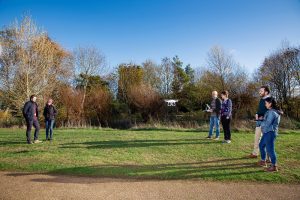The future of education isn’t all about pushing technology into classrooms, says the latest report into teaching trends from The Open University. The Innovating Pedagogy Report 2019 identifies strong moves towards more creative, informal teaching methods – such as teaching through wonder, playful learning and even building empathy by bringing a baby in to the classroom – allowing learners to be more experimental and inventive in how they explore topics.
The report, compiled by experts from The Open University and the Centre for the Science of Learning & Technology (SLATE) in Norway, identifies ten innovations that will influence education internationally over the coming years.
Less reliance on technology
Lead author of the report, Dr Rebecca Ferguson, Senior Lecturer, Institute of Educational Technology at The Open University, said: “Although we’ve looked at trends that make use of drones and robots, the future of teaching and learning isn’t all about hi-tech devices. This report identifies many trends that don’t require technology, and which can be tried straight away.
“Bringing wonder and play into learning and looking at social and emotional learning are all trends that will have a big impact on teaching and learning, without a reliance on technology.”
The 10 highlighted trends in the Innovating Pedagogy 2019 report are:
1. Playful learning

Learning through play is a creative and informal teaching method
Learning through play evokes creativity, imagination, and happiness. It focuses on process rather than outcome and allows learners to explore issues with freedom. Play provides an important alternative to the increasing focus on memorisation, testing, and performance in education.
2. Learning with robots
Conversations between teachers and learners are important but take time. An artificially intelligent robot can respond quickly to frequent queries or even help a teacher with assessment. This can free teachers to direct more time towards human tasks such as exercising judgement and giving emotional support.
3. Decolonising learning
As education is increasingly globalised, communities are challenging the assumption that the European tradition offers the most valuable knowledge and the best ways of teaching and learning. This trend prompts us to consider education from a different perspective, showing how the world view presented to learners is often white, male and European. It is about recognising, understanding and challenging the ways in which our world is shaped by colonisation.
4. Drone-based learning

Drones help people view inaccessible places
Using drones, students can view otherwise inaccessible landscapes, or see them from different angles. They can collect data in places that would otherwise be difficult or dangerous to access. Using drones can help learners develop new skills such as interpreting visual information from a landscape, and it enriches the exploration of many physical spaces.
5. Learning through wonder

Amazing natural phenomenon can spark curiosity
A wondrous event such as seeing a brilliant rainbow or majestic waterfall creates an experience that provokes interest and curiosity. By investigating encounters in the everyday world, a desire to understand leads to learning – and learners are motivated to see a phenomenon from many perspectives. Recently developed curriculum designs and Wonder Classrooms provide new ways of bringing these experiences into classrooms.
6. Action learning
This is a team-based approach to professional development that addresses real problems. It is designed to improve existing skills and solve problems significant to those taking part. Learners work in small groups of diverse people with a facilitator, and each person brings a problem or issue of concern. Meeting regularly, group members find and apply solutions, encouraging shared experiences and reflection.
7. Virtual studios
This trend extends to the online environment the creativity, collaboration and social interaction of a physical studio. It gives learners increased access to a range of solutions to design problems and provides opportunities to work with other learners and professionals around the world.
8. Place-based learning
This is about using technology to extend how we use locations for education. Varied locations can be triggers for learning, for instance using the natural environment or a community setting to inspire learners. Mobile technologies are opening up new opportunities for place-based learning, providing a variety of tools to support study outside the classroom.
9. Making thinking visible
Learning is more effective when students can visualise their thinking. Using visual concepts, mind maps, and writing helps teachers see their students’ progress. These visible records can become resources for student reflection, and also help teachers to identify and address student misunderstandings.
10. Roots of empathy
This is a classroom programme for primary-age children that helps develop empathy. A baby is brought into the classroom and is seen as a ‘teacher’. The children in the class learn about development and emotions, talk about what the baby is doing, and develop a sense of responsibility. The method has been shown to foster good social behaviour and decrease aggressive behaviour.
Main image: copyright Roots of Empathy



